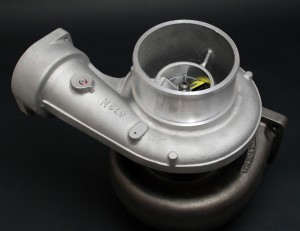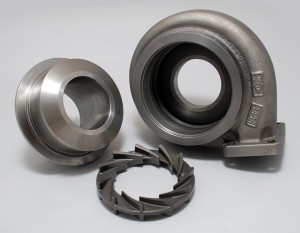 Turbochargers are a critical part of the trucking industry because they significantly boost a diesel engine’s horsepower without significantly increasing its weight. However, economical concerns have truckers looking beyond improved horsepower and torque to additional ways to improve fuel efficiency. The question remains: is there a turbocharger that has the potential to increase horsepower and torque while improving fuel economy?
Turbochargers are a critical part of the trucking industry because they significantly boost a diesel engine’s horsepower without significantly increasing its weight. However, economical concerns have truckers looking beyond improved horsepower and torque to additional ways to improve fuel efficiency. The question remains: is there a turbocharger that has the potential to increase horsepower and torque while improving fuel economy?
Truck owner and operator Larry Olsen of Mitchell, South Dakota believes he’s found the answer to this question with the new Big Boss Nozzle Ring Technology Turbocharger from PDI. Olsen, a licensed hauler in 48 states, recently repowered his 1982 A-Model Kenworth with a 6NZ C-15 Cat engine. He decided to repower his truck with an electronic motor, because he was “looking for maximum performance and fuel economy.”
Last May, Olsen installed the new Big Boss Nozzle Ring Technology Turbocharger on his truck. There are many advantages to the new nozzle ring turbine housing over standard turbine housings and, furthermore, over the variable geometry turbo found on most newer engines. Olsen said, “With the newer engines being so tweaked down for emission requirements, it’s hard to get power and efficiency out of them.” Because of this, he committed to overhauling his older KW until it was both powerful and fuel-efficient.
Olsen installed the nozzle ring turbo because, “it offers better drive-ability and passing power, and it’s better for hills because you are not downshifting as much.” The Big Boss Nozzle Ring Technology Turbocharger takes advantage of not only the exhaust pressure, but also the exhaust gas velocity to spin the turbine wheel, allowing the turbo to spool up much quicker with less exhaust turbine drive pressure than a conventional turbocharger or the newer variable geometry turbochargers on today’s engines.
This new nozzle ring turbocharger has a very large turbine housing which provides a higher air volume ratio (A/R) and lowers exhaust drive pressure. This would normally make the turbocharger spool up much slower, but with the implementation of the nozzle ring and its perfectly-angled vanes, it directs the exhaust gasses at the exact angle – just off tangent of the turbine wheel. The turbo spools up much quicker with less exhaust drive pressure than the factory turbocharger. Olsen said, “The new nozzle ring technology spools the turbo with less effort, and that’s better for the engine.”
 The nozzle ring turbo places nozzle vanes at the perfect angle of efficiency. The number of vanes that the nozzle ring has determines the effectual A/R of the turbine housing. For example, a 13-vane nozzle ring has a smaller effectual turbine A/R, while the 11-vane nozzle ring has a larger effectual turbine A/R. The benefit of this new turbine housing is that the nozzle rings are totally interchangeable without removing the turbo from the engine. By removing the final exhaust band clamp and the clamp that holds the nozzle retainer ring in place, the nozzle rings can then easily be changed. Olsen decided to purchase the new turbo because, as he put it, “essentially, when you buy it, you get two turbochargers for the price of one.”
The nozzle ring turbo places nozzle vanes at the perfect angle of efficiency. The number of vanes that the nozzle ring has determines the effectual A/R of the turbine housing. For example, a 13-vane nozzle ring has a smaller effectual turbine A/R, while the 11-vane nozzle ring has a larger effectual turbine A/R. The benefit of this new turbine housing is that the nozzle rings are totally interchangeable without removing the turbo from the engine. By removing the final exhaust band clamp and the clamp that holds the nozzle retainer ring in place, the nozzle rings can then easily be changed. Olsen decided to purchase the new turbo because, as he put it, “essentially, when you buy it, you get two turbochargers for the price of one.”
At first, Olsen installed the 13-vane nozzle ring turbocharger before deciding that the 11-vane turbo would give him “the power and fuel efficiency” he was looking for. Olsen said that he installed the nozzle ring turbo because he could tune it to his needs. With his 11-vane nozzle ring turbo, he said that he has noticed a difference in the top end pulling power on steep grades. With its unique ring and fins design, the turbocharger draws a larger volume of air quicker into the turbine wheel, giving the truck more power.
With this new turbo, a truck can be tuned to the specific horsepower and driving style of the operator in a matter of minutes. In addition to the increased horsepower and torque, Olsen’s Kenworth, with the new turbo installed, is very efficient (he expects to see excellent fuel economy). But, the best aspect of this new turbo is that it is tune-able, so he can change the horsepower and throttle response at any time. And, best of all, he can do that without having to purchase a new turbo, just a new ring.
Olsen noted that the new nozzle ring technology turbocharger was more efficient and reliable then his stock turbocharger, but he cautioned truckers by saying, “Although it seems like a lot of money to spend, in a year’s time the parts will pay for themselves.” With this new turbocharger, the most noticeable difference an owner operator will see and feel is the quickness of turbo response, increased fuel economy and the ability to pull the engine lower in the rpm range without turbocharger surge. The Big Boss Nozzle Ring Technology Turbocharger allows truckers to save money through improved fuel economy and increase horsepower and torque – which is exactly what every trucker out there wants.
Performance Diesel Inc. (PDI) of St. George, Utah is the owner of this new and patented Big Boss Nozzle Ring Technology Turbocharger. The nozzle ring technology turbocharger was added to PDI’s Big Boss product line-up back in April of 2011. For more information about the new turbo or for questions regarding your technology needs, contact your nearest PDI dealer or call them directly at (800) 511-1231.
